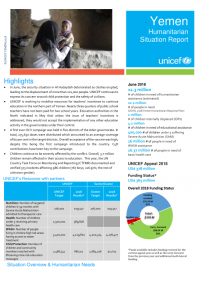UNICEF Yemen Humanitarian Situation Report (June 2018)
Highlights
• In June, the security situation in Al Hudaydah deteriorated as clashes erupted, leading to the displacement of more than 121,000 people. UNICEF continues to express its concern around child protection and the safety of civilians.
• UNICEF is working to mobilise resources for teachers’ incentives to continue education in the northern part of Yemen. Nearly three quarters of public school teachers have not been paid for two school years. Education authorities in the North indicated in May that unless the issue of teachers’ incentives is addressed, they would not accept the implementation of any other education activity in the governorates under their control.
• A first ever OCV campaign was held in five districts of the Aden governorate. In total, 275,650 doses were distributed which amounted to an average coverage of 60 per cent in the target districts. Overall acceptance of the vaccine was high, despite this being the first campaign introduced to the country. C4D contributions have been key to the campaign.
• Children continue to be severely affected by the conflict. Overall, 3.7 million children remain affected in their access to education. This year, the UN Country Task Force on Monitoring and Reporting (CTFMR) documented and verified 573 incidents affecting 986 children (767 boys; 216 girls; the rest of unknown gender).
Situation Overview & Humanitarian Needs
Between January and June this year, humanitarian needs in Yemen remained high despite efforts to renew peace talks. The conflict affects millions of people throughout the country, but children continue to bear the heaviest toll of the conflict. Since January, 92,623 cases and 72 deaths have been reported due to acute watery diarrhoea (AWD)/cholera. Out of every 10,000 people, an average of 396.5 are affected by AWD/cholera. Children under 5 represent 28.8% of the total suspected cases. As of 24 June 2018, local health authorities confirmed a cumulative total of 1,907 suspected diphtheria cases, included 98 associated deaths with Ibb and Sana’a among the most affected governorates. Children between 5-15 years old are the most affected, representing 44% of all cases.
Children’s right to an education continues to suffer under the conflict, as nearly three-quarters of public school teacher have not received salaries for more than a year and over 3.7 million children are affected in their access to education. As schools continue to be damaged by the conflict, have closed or now serve as shelters for displaced families, more than 2 million children are out of school – compared to 1.6 million before the conflict. UNICEF is engaged in ongoing advocacy efforts to address these challenges and to mitigate its effect on current education activities. In addition, UNICEF has started discussions with donors for the mobilisation of resources for teachers’ incentives.
During the first half of 2018, the UN Country Task Force on Monitoring and Reporting (CTFMR) documented and verified 573 incidents affecting 986 children (767 boys; 216 girls; the rest of unknown gender). Since the start of the conflict, from March 2015 to June 2018, the Monitoring and Reporting Mechanism (MRM) on grave violation of child rights verified 2,398 children killed, 3,652 children maimed, and over 2,635 children have been recruited and used by armed forces and groups. The MRM network currently covers 735,817 children in most conflict affected areas. Moreover, schools and hospitals have been frequently attacked and used for military purposes, denying children access to their right to education and health care. At least 425 attacks on and military use of schools and hospitals have been documented and verified.
Yemen continues to be one of the world’s most difficult operating environments for humanitarian actors. Fighting erupted along the Western coast of Yemen in June, affecting Al Hudaydah, a port city and one of the major lifelines to Yemen’s population. The fighting displaced more than 121,000 people in Al Hudaydah governorate. UNICEF and Humanitarian actors have been able to provide 80,000 people with various forms of life-saving assistance. Humanitarian actors are also addressing the needs caused by the tropical cyclone that affected Socotra on 23 May, which caused the displacement of 1,003 households and affected 60,000 people.


